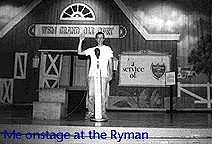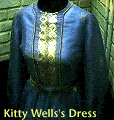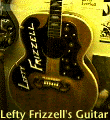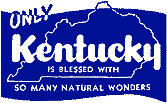Day 41 -- Wednesday, June 10
I rolled out of Memphis
last evening, still a bit dazed from Graceland, and headed for Nashville.
It was the week of Fan Fair, a week-long gathering of country music performers
and fans with performances, autograph signings, etc., so I was a bit concerned
about lodging but I found a spot without too much trouble.
I got up this a.m.
and headed for the Ryman Auditorium. This was formerly the home, from the
'40s until the '70s, of the Grand Ole Opry and it's a great place.
They've left it pretty much as it was when the Opry was presented here. The
original backdrop still hangs at the back of the stage, as if Porter and Dolly
might walk out and do a song at any moment.
Visitors are allowed access to
the stage. It's an excellent photo opportunity: you on the stage with that big
barn backdrop, standing behind the same microphone that so many country stars
sang into over the years.
The Ryman was originally built as a church, the
Union Gospel Tabernacle. Capt. Tom Ryman, owner of a steamboat line, had it built
to honor Sam Jones, the evangelist who showed him the path to heaven. Completed
in 1892, it was re-named the Ryman Auditorium when the steamboat magnate went to
his final reward in 1904. The big hall was renowned for its acoustics and it
soon became host for entertainment events, political gatherings, meetings, and
rallies in addition to its ongoing church services. The balcony was added in
1897, the stage in 1901. In the early years, such luminaries as Sarah Bernhardt,
Enrico Caruso and Will Rogers trod the boards here.
In 1920, the last
legitimate theatre in Nashville was turned into a movie house, so the Ryman was
in even greater demand. All the touring theatrical and musical companies that
came through town appeared there. From the Twenties on through World War II, such
stars as Katherine Hepburn, Helen Hayes, Orson Welles and Ethel Barrymore
appeared onstage at the Ryman.
 In 1943, the Ryman became the new home of the Grand Ole
Opry. Every Saturday night, the hall's 3,000 seats were filled with
country music fans thrilling to the sounds of Hank Williams, Patsy Cline, Roy
Acuff, Ernest Tubb, Marty Robbins and so many others, while millions more
listened in their homes to WSM's remote broadcasts.
In 1943, the Ryman became the new home of the Grand Ole
Opry. Every Saturday night, the hall's 3,000 seats were filled with
country music fans thrilling to the sounds of Hank Williams, Patsy Cline, Roy
Acuff, Ernest Tubb, Marty Robbins and so many others, while millions more
listened in their homes to WSM's remote broadcasts.
In 1974, the Opry moved to
its new home in Opryland U.S.A., opting for slicker surroundings, even as country
music itself was growing slicker and more pop-oriented. So, if you'd rather see
the site where Patsy and Hank performed, as opposed to the one where Garth and
Reba strut their stuff, then the Ryman should top your list when you're in
Nashville.
Following the Ryman, I took in the Country Music Hall of
Fame. I must say that I was quite impressed with this facility. Somebody with
a little taste and style is behind this, that's for sure.
I once read that
there is no market for an oldies station in country music. Apparently, this
format has been tested and has always failed. This is quite a contrast to rock
and pop music. In fact, as I've traveled the eastern half of the U.S., I've been
amazed at how widespread the oldies format has become. As one drives from town to
town and state to state spinning the radio dial, one constantly comes across an
old Motown hit, a Monkees tune or a favorite by the Beatles. These stations are
everywhere and their broadcast areas overlap greatly. Often, on a single spin
through the AM and then the FM dials, one can find five or six stations playing
blasts from the past.
For some reason, though, this approach doesn't appeal to
most country fans. Knowing this, I wondered if the Country Music Hall of Fame
would give proper due to the stars of yesteryear and the year before that. I'm
pleased to report that it does. In fact, there's a bit of scholarship evident in
the museum's displays. One can actually learn quite a bit about the origins of
this very popular music.
I'm certain that many of the fans who come through
the Hall, hoping to get a look at one of Garth Brooks' hats or Naomi Judd's
guitars, have never before heard of Jimmie Rodgers, the Carter family or others
of the pioneers of Country and Western. Many of them leave this place just as
ignorant, too; if a display isn't about Alan Jackson, Vince Gill or Clint Black,
I noticed that many of the visitors pass right by. But, to the Hall's credit,
anyone who takes the time to read the information given, to listen to the
narrated voice-overs and to watch the old film clips will learn a great deal
about the history of this music.

 They have plenty of artifacts for the casual fan to
see as well. Elvis Presley's solid gold Cadillac, Patsy Cline's cigarette
lighter, Hank Williams's guitar, one of Dolly Parton's costumes (it's not hard to
tell, at a glance, whose costume it is, if you know what I mean), and an entire
room devoted to the career of Johnny Cash's career. The admission price to the
Hall of Fame also gains admittance to Studio B a couple of blocks away.
This recording studio was used by some of the greats of country music in the
'50s, '60s, and '70s, including Elvis, Dolly, Roy Orbison and Waylon
Jennings, and makes for an interesting half hour.
They have plenty of artifacts for the casual fan to
see as well. Elvis Presley's solid gold Cadillac, Patsy Cline's cigarette
lighter, Hank Williams's guitar, one of Dolly Parton's costumes (it's not hard to
tell, at a glance, whose costume it is, if you know what I mean), and an entire
room devoted to the career of Johnny Cash's career. The admission price to the
Hall of Fame also gains admittance to Studio B a couple of blocks away.
This recording studio was used by some of the greats of country music in the
'50s, '60s, and '70s, including Elvis, Dolly, Roy Orbison and Waylon
Jennings, and makes for an interesting half hour. 
I had to leave Music City
and head north, giving short shrift to Kentucky along the way. I was due in
Chicago early Friday morning and so intended to reach Indianapolis tonight. I
took I-65 north, passing right through Louisville and on into Indiana. I
arrived in Indianapolis around midnight.
 In 1943, the Ryman became the new home of the Grand Ole
Opry. Every Saturday night, the hall's 3,000 seats were filled with
country music fans thrilling to the sounds of Hank Williams, Patsy Cline, Roy
Acuff, Ernest Tubb, Marty Robbins and so many others, while millions more
listened in their homes to WSM's remote broadcasts.
In 1943, the Ryman became the new home of the Grand Ole
Opry. Every Saturday night, the hall's 3,000 seats were filled with
country music fans thrilling to the sounds of Hank Williams, Patsy Cline, Roy
Acuff, Ernest Tubb, Marty Robbins and so many others, while millions more
listened in their homes to WSM's remote broadcasts.
 They have plenty of artifacts for the casual fan to
see as well. Elvis Presley's solid gold Cadillac, Patsy Cline's cigarette
lighter, Hank Williams's guitar, one of Dolly Parton's costumes (it's not hard to
tell, at a glance, whose costume it is, if you know what I mean), and an entire
room devoted to the career of Johnny Cash's career. The admission price to the
Hall of Fame also gains admittance to Studio B a couple of blocks away.
This recording studio was used by some of the greats of country music in the
'50s, '60s, and '70s, including Elvis, Dolly, Roy Orbison and Waylon
Jennings, and makes for an interesting half hour.
They have plenty of artifacts for the casual fan to
see as well. Elvis Presley's solid gold Cadillac, Patsy Cline's cigarette
lighter, Hank Williams's guitar, one of Dolly Parton's costumes (it's not hard to
tell, at a glance, whose costume it is, if you know what I mean), and an entire
room devoted to the career of Johnny Cash's career. The admission price to the
Hall of Fame also gains admittance to Studio B a couple of blocks away.
This recording studio was used by some of the greats of country music in the
'50s, '60s, and '70s, including Elvis, Dolly, Roy Orbison and Waylon
Jennings, and makes for an interesting half hour. 
